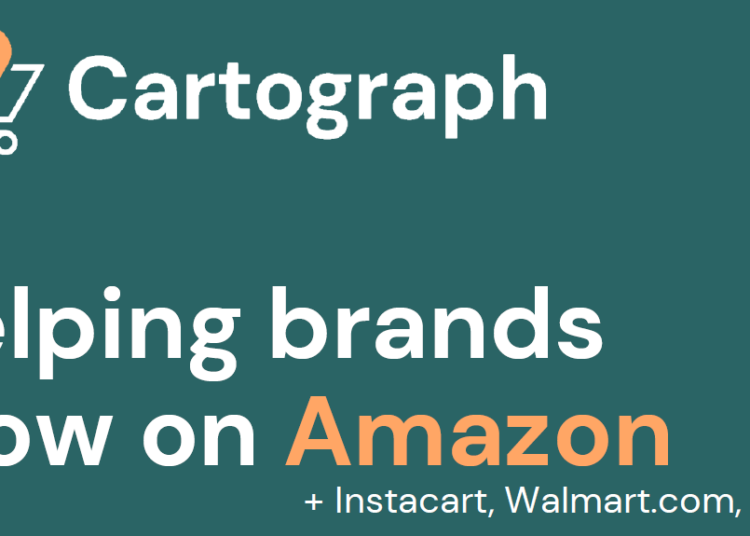Amazon Marketplace: Selling there profitably is possible but not easy
(Courtesy: Cartograph)
On Monday’s The Stockout show, I will interview Chris Moe, CEO of Cartograph, a company that helps brands grow profitably on Amazon and Instacart. The numerous and interconnected challenges associated with selling on Amazon Marketplace (i.e., the 60% of Amazon revenue that involves third parties selling their own inventory) were highlighted in last month’s legal complaint brought by the Federal Trade Commission (FTC) and 17 attorneys general.
In the lawsuit, the plaintiffs allege that Amazon is abusing its monopoly position by forcing sellers to limit discounts on competing online superstores while also requiring sellers to buy advertising on Amazon in order to win the “buy box.” In addition, the FTC finds Amazon’s practice of requiring sellers to use its own fulfillment services in order to qualify for Amazon Prime to be an abuse of a monopoly position.
With those challenges as background, Moe has plenty of ideas for sellers hoping to make a buck on Amazon. He advises that sellers craft their products starting upstream — with product designs and packaging sizes that lend themselves to profitable e-commerce. For consumables, that often involves larger product sizes — a grocery item that retails for $3-$5 may have to be expanded into a variety pack to sell for $15-$20. It’s also critical for products that fit into Amazon’s standard box sizes.
Remarkably, through those and other strategies, over 90% of sellers that Cartograph advises are profitable on Amazon Marketplace. Moe believes that to sell adequate volume on Amazon, sellers need to win the “Prime badge,” since Prime customers buy four times as much as non-Prime customers (~$2,000 per year versus ~$500 per year), and that may require using Amazon’s own fulfillment services. Fortunately for sellers, Amazon tends to price freight rates fairly, according to Moe.
The show will air on FreightWaves.com at 2 p.m. EDT Monday and will be available on the FreightWaves YouTube channel and podcasting services thereafter.
Largest chassis leasing company sees intermodal growth ahead
Following up on Joanna Marsh’s article, I will interview TRAC Intermodal President and CEO Dan Walsh on Tuesday on FreightWaves’ People Speaking Rail show. The show will air at 2 p.m. EDT on FreightWaves.com.
Shippers will be relieved to hear that Walsh does not expect disruptions in chassis availability similar to those the industry experienced in 2021. At that time, chassis availability was constrained due to a combination of extraordinary events, some related to COVID and others related to the tariffs that suppressed the production of new chassis. With those issues in the rearview mirror, and recent investments in intermodal terminals and equipment, Walsh expects meaningful intermodal growth next year. He highlights recent data and expectations from the National Retail Federation, which shows continued growth in retail spending in the face of inflationary pressure on consumers. While intermodal traffic has picked up seasonally in October, Walsh considers that to be a “blip” rather than a surge and he sees few, if any, capacity constraints currently in carriers’ intermodal networks.
Domestic rail intermodal volume has picked up in October. (Chart: SONAR – ORAILDOML.USA)
Domestic intermodal volume rises as value proposition improves
(Chart: SONAR – IMCRPM1.USA)
Due to improvements in rail service and falling rates, the value proposition of rail intermodal has improved for shippers. The service data collected by the U.S. Surface Transportation Board shows that the weekly average number of intermodal cars that have not moved in at least 48 hours is favorably down across the board on the Class I railroads. Meanwhile, the SONAR chart above highlights falling contractual rates — which were down 17% year over year (y/y) in Q3, excluding fuel surcharges. Those metrics, combined with the favorable impact of seasonality, are contributing to a strong start to the fourth quarter for loaded domestic containerized intermodal volume — which is up 4.2% y/y in the first 26 days of October. That compares favorably to a 1% y/y increase in long-haul (more than 800 miles) tender volume during the same period.
To subscribe to The Stockout, FreightWaves’ CPG and retail newsletter, click here.
The post Upcoming shows feature experts on Amazon and intermodal appeared first on FreightWaves.














